

Facing the Facts of Animal Treatment
Awareness of some of the violent practices to which nonhuman animals are routinely subjected.
This pamphlet was composed for a group I co-founded, called University of Toronto Students for the Ethical Treatment of Animals (U of T SETA). It was designed to inform fellow activists of some of the practices to which nonhuman animals are routinely subjected. Laws have scarcely changed since my work with SETA, and the same can be said of common practices described. One activist reported that she was as profoundly affected by its contents as anything she ever read. Most people have little idea of what is actually done to animals behind closed doors of ultrasecure labs, and barricaded slaughter facilities.
Many people associate animal rights with atrocity images of animals. In a certain sense there is no logical reason for this, since it is animal abusers who inflict cruelty to animals, not animal rightists. However, there is a simple psychological reason for this association: animal rights groups continually display atrocity images to protest how animals are commonly mistreated. Yet animal rights leads to animal liberation. The logical outcome of animal emancipation? The realities and hence images of liberated animals. In keeping with this theme, I wish to highlight some portraits of liberated animals to start off, to make it clear what the ends of animal rights really are--animals as ends in themselves:
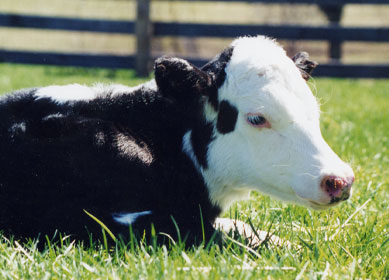
A liberated cow
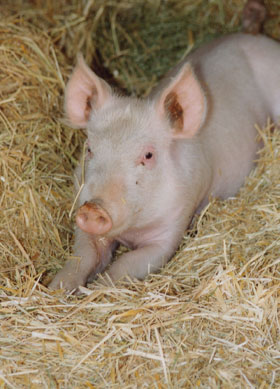
A emancipated pig
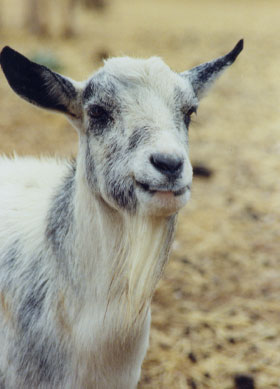
A goat living under conditions of animal rights
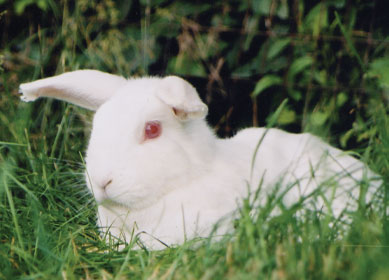
A bunny relishes an oasis of animal liberation
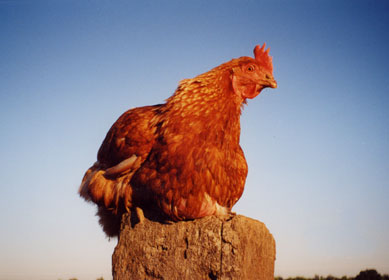
A rooster helps herald the dawn of the animal sanctuary movment
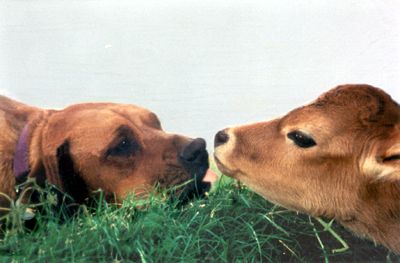
A dog and a calf participate together in an environment characterized by intentional nonaggression

A human and a cow commune under conditions of relative equality
However, mostly animals are treated under conditions of extreme oppression, and it would not be fair to neglect them either in our minds or concrete practices. Hence the purpose of "Facing the Facts of Animal Treatment." There appears nothing wrong in the above images. Yet animal rightists need to defend their practices in this world. Keep in mind that the images and descriptions below are not associated with animal rights so much as contempt for animal rights. Also, although they might be upsetting, this upset pales in comparison to the severe harm animals must endure at human hands, usually for trifling benefits.
This concept means arbitrary discrimination on the basis of species membership, and is analogous to racism, sexism, and ageism. Just because a creature is not human, or lacks certain human-like characteristics, a speciesist denies that creature moral standing or assigns a reduced moral standing. If this anthropocentricism (being centrally concerned only with humans) is to be defended, one needs criteria of moral standing other than just species membership. Criteria must have universalizability, measurability, and especially relevance. If one uses the usual would-be criteria to exclude animals (language ability, self-awareness, rationality), then some animals are included (e.g., dolphins and apes: chimpanzees have been taught American Sign Language), whereas some humans are excluded (e.g., the severely mentally retarded, the comatose, the very brain-damaged, the very senile, and perhaps human infants, although the latter may potentially fulfil the criteria). Animal rightists generally agree that sentience (conscious awareness, ability to feel), having interests, or having a welfare (these criteria overlap) are more reasonable and relevant criteria for moral standing. Consider measurability: the claim that animals have no souls is unverifiable. Consider relevance: we do not give more intelligent humans the right to exploit other humans, so how could the lesser intelligence of at least some nonhumans be relevant? Many animal rights advocates believe that all sentient beings should be given equal consideration, not necessarily equal treatment (e.g., monkeys should not be given the vote, but their welfare should be considered comparably with our own).
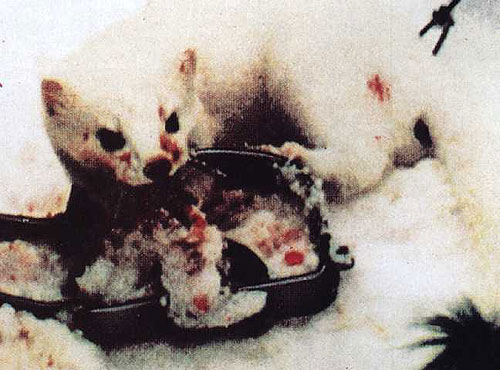
Trapped mink tries gnawing off leg to get free of leg-hold trap
The notion of a 'humane trap' is not only a fiction that many animals in labs have horrifically been killed for, but is, in fact, a contradiction in terms. Even if such a trap were possible, which it isn't, few trappers would pay for the extra expense. The Coniber trap, again, developed as a less cruel trap, in that it would strike a killing blow to the back of an animal's head. However, different kinds of animals often find their faces, stomachs, etc. snapped shut in this kind of trap.
Often mother animals are victims of trappers, leaving their children to face a merciless death of hunger. One famous self-styled Indian who renounced trapping, Grey Owl, found a mother animal suckling her young as she lay in the trap, despite her terror and pain. He saved the family, but these were lucky exceptions. Also, creatures like foxes and wolves mate for life, so life-long spouses are often bereaved.
For every animal caught who is of a 'target species,' two more are unwanted animals (including stray pets), and these are called 'trash' in the trappers' crude jargon. 'Trash' like hapless fawns, squirrels, geese, ducks, owls, songbirds, turtles, or members of endangered species, like golden eagles, are simply discarded alongside the trap. Some pets get to be released and may be able to return to their owners, only to have their gangrenous legs amputated by a vet, necessarily adding danger to their lives. One cat was found with agony on its face, bark clawed from a tree, the earth around torn and bloody.
Trappers kill those animals still alive when found by clubbing, breaking their necks, strangling, or even by beating and stomping them to death (these methods avoid damaging the pelt, unlike too-expensive bullets).
Of all the millions of North American animals trapped annually, perhaps 1% might be trapped by native people. Trapping is not the 'way of life' it once was in Canada, but is an income supplement of an average $700 (less taxes) for 80-90% of trappers.
It is not a part of traditional native culture to trap skins for women to wear as a luxury, and although the industry claims to uphold native culture, any historian can tell you that the fur industry historically has helped to dismantle and destroy indigenous cultures from the 17th century onwards. Trapping for cash helped make natives dependent on European newcomers and their commodities, thus helping to destroy aboriginal culture and putting impoverished aborigines into debt. Moreover, the Fur Council of Canada refused to label native-trapped furs as such, which shows just how sincere is their present-day 'commitment' to the natives. Native Animal Brotherhood even reports that the government restricts native territories that are not in 'use' (i.e., for trapping), and will also starve reservations of social assistance cheques, even in the harshness of winter, if the natives refuse to trap.
Since trapping is non-selective killing, it is invalid as a form of disease and predator control. Furs from beaver, coyote, ermine, fisher, fox, lynx, marten, muskrat, opossum, otter, rabbit, raccoon, skunk, squirrel, or wolf are likely from trapped animals.

Maddened by imprisonment on a fur farm
Experts believe that 'ranched' fur-bearers suffer even more cruelty than trapped ones, since the former animals lead an impoverished, futile and frustrating lifetime in captivity. Fur-bearing animals on farms are kept in very small wire-bottomed cages, crowded into rows of sheds. The average size for a mink cage is 10 x 12 x 24 ins. Half of today's bred minks are mutants bred for desired textures and colours, which commonly leads to chronic diseases, including bleeding membranes, painfully deformed sex organs, and total deafness and blindness. They often develop a constant nervous habit of jerking their heads, or engage in self-mutilation, such as tearing off their own fur or flesh. During breeding, resistant females often have their muzzles strapped shut with adhesive tape to avoid fighting which might damage pelts. Crazed, caged minks may unnaturally devour their offspring. Massively frustrated instincts often cause constant racing back and forth in the cage, and other insane motions. A mink in the wild would normally roam across acres of territory for 2.5 years, but confined to a small cage, it lives hellishly for 6 months. Their feed includes the bodies of dead minks.
These 'ranched' animals are killed as cheaply as possible by highly unregulated methods: home-made electroshock boxes, neck-breaking, painful gassing, cyanide, decompression, or cheap injection by unskilled workers. Farmed minks may be killed by being placed in a box, into which chloroform is then poured. A common way of electrocuting foxes to death is by forcing the animal to bite down on an electrode, while another is stuck in the anus, thus completing the 'circuit.' Done by untrained help, this can distress and hurt the creature. When the struggling stops, the mink is removed from the box and his head is squeezed into a jar, resulting in painful suffocation. A full-length female ranched mink fur coat can contain up to 60 such animals. On foreign continents, some animals are killed by a red hot metal rod inserted in the anus. The chosen method of killing suggested by veterinarians, sodium pentobarbital, is rarely used due to cost.

Rabbits immobilized for Draize Test
Each year, millions of animals, perhaps upwards of 20 million, in North America alone, are subject to painful and fatal products testing, and 500,000-1,000,000 are killed in cosmetics tests only. These tests force animals to eat makeup, oven-cleaner, pesticides, etc., in amounts that no human would ever consume, yielding conclusions which are not sound for applying to humans, even overlooking vast species differences (and differences among breeding strains). Results are hopelessly complicated by lack of food and water (indeed, the test animals may be rendered incapable of eating or drinking), and stressful living conditions such as total isolation (as well as the inescapable variations across species).
In the LD-50 test, animals are usually force-fed, but may also be forced to inhale spray, or be injected with dosages of a given substance until fully 50% of the animals die. The rest are then killed by other means. Short-term or acute toxicity LD-50 tests find lethal dosages. Often, the substances are fairly harmless, so they are force-fed to 60-100 animals until the creatures die of the large volume or high concentration (often causing severe internal burns) given to them. Animals naturally resist eating the bitter substances, so often they are force-fed with pellets of the noxious substances, or by using stomach tubes, or a hole cut in the animal's throat. Ruptured stomachs or intestines caused by massive blockage often occur, as does extreme nausea, vomiting, diarrhea, loss of appetite, wheezing, bleeding from eyes, nose and mouth, convulsions, paralysis, and possibly coma. The chronic toxicity text is used with smaller dosages over longer periods (in rabbits or rats the period is 2 yrs.; in dogs - often beagles are used - the time is up to 7 yrs.; mice and Guinea pigs are also used for these tests). Animals are often very ill during chronic tests, often just on the brink of extinction. Skin irritancy tests require that hair be removed, and this is done by applying adhesive tape, and rapidly drawing it away. The test substance is then held to the skin for at least 24 hours with either a rubber sleeve or gauze tape. The animals are immobilized to prevent chewing of the rubber sleeve. Rabbits have suffocated from getting their paws trapped in a restraining collar, or have died from ingesting gauze or plastic cellulose. Obviously, killing 50% of animals with intensive quantities and concentrations of a substance is irrelevant in determining what is poisonous to a human being.
In the Draize test, rabbits are usually used to test cosmetics. In this test, high concentrations of the substance are eye-dropped onto the animals' eyes, often over several days, and the animals are held in clamps to prevent clawing of eyes, with clips to keep their eyes open. Since rabbits cannot produce tears to flush out foreign substances, their capacity for eye irritation is much greater than that of humans. Moreover, their cornea itself is far more sensitive than ours (which is why rabbits are used most often; occasionally, dogs and primates are also used). Rabbits often break their necks trying to squirm away from the eyedrops. Normally very silent creatures, rabbits often scream during such tests.
In Britain, it is estimated that 1 million animals die each year from cosmetic testing alone (this does not include shoe polish, food colouring, etc.). New products, to be approved as safe by the U.S. Food and Drug Administration, must be presented with a thick file on animals who have been poisoned by the product. No Canadian law or regulation exists specifically requiring the use of animals in cosmetics testing, so it is especially inexcusable that companies continue this needless abomination.

Faces from factory farming
Modern, intensively farmed animals suffer especially in their growth period, but also in their journey to the slaughter house, and in the slaughtering itself. Suffering is only ever considered by the factory farmers, however, if a given stress prevents the animals from gaining weight. Meat, after all, is sold by the pound. Five billion animals are killed each year for the U.S. meat market---over 95% of all animals routinely killed by humans. Hundreds of millions of cattle, pigs, and sheep are raised and slaughtered in the U.S. alone, and the figure for poultry is more than three billion creatures. This makes factory farming by far the most extensive form of exploitation on the planet. Since World War II, farming was no longer controlled by country folk, but became a profits- and production- maximizing, big business operated by large corporations (like Greyhound) with factory-like, assembly-line type methods. Small producers are pressured by market forces to adopt 'factory farm' methods too, in order to remain profitable. Some egg production plants contain a million or more egg-laying hens under very crowded conditions. Costs are minimized, and production is maximized, which leaves no sympathy for the animals, who are regarded explicitly as "food machines"; in agribusiness trade journals.
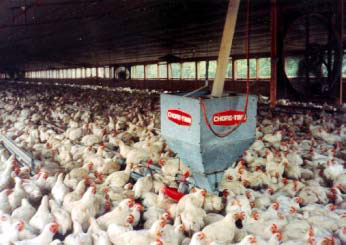
Maximum crowding
'Broiler chickens' and turkeys are standardly raised in highly automated factory-like plants of large corporations, which own or control 98% of all U.S. 'broiler' production. Only females are used in the broiler industry (as distinct from the males used by breeders), so male chicks are discarded, mashed live, gassed, or suffocated. Hapless broiler chicks arrive at producers via conveyor belt from incubators and mechanized hatcheries. Chickens are kept in long, windowless sheds which can contain 80,000 birds in an area the size of a football field, yielding only 1/2 a square foot per bird once the group has fully grown in 8-9 weeks with artificial aging stimulation (the natural lifespan of a chicken is about 12 years). This deprives them of room to stretch their wings, dust-bathe, build nests, and they never get outside air or sunlight until taken out to slaughter. Or in some intensive systems, 'broilers,' who are light sensitive animals, as roosters demonstrate by their heraldings of the dawn, are exposed to bright light for 24 hours a day for the first two weeks, then the lights are dimmed slightly and go off and on every 2 hours, until at 6 weeks old they are plunged into total darkness since they are so crazed by this point in time. The air is heavy with ammonia from chicken droppings. If the ventilation system fails, the birds soon suffocate (e.g., fans shut down in a power failure). Through automation, 60-80,000 birds can be attended by one man, and so they can get no inspection and no human care except the removal of dead birds (the U.S. Department of Agriculture endorses this method in their literature). Chicken food is not designed for promotion of health, but is simply meant to provide as much cheap weight gain as possible. A U.S. government report found that 90% of chickens from most flocks are afflicted with chicken cancer.
These unnatural conditions among 'broilers' lead to unnatural fighting, killing, pecking, and cannibalism among these otherwise highly social animals. Hence they are kept in the dark in later stages, and their beaks, their most versatile members for preening, etc., are usually cut off by a guillotine-like device, or a hot knife - these beaks have nerves like the quick of our fingernails, so debeaking is comparable to tearing off a nail without anesthesia.
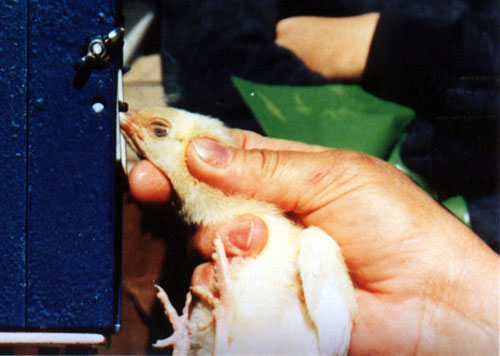
Debeaking a chick with a guillotine
De-beaked chickens sometimes cannot eat or drink at all, or not much, due to irregular beak growth following the grisly operation. Birds, like mammals, have a well-developed diencephalon, a part of the brain which enables them to fully feel and suffer (incidentally, fish have well developed brains and nervous systems and are as likely to feel pain as any other vertebrate, according to noted British zoologist, Lord Medway). The chickens are fed antibiotics which can push them beyond natural growth limits such that their bones collapse, as the bones and joints cannot keep pace with the unnatural flesh growth. Birds recognize one another and establish a social order in groups of up to 90 birds, but obviously this is not possible in sheds of at least 10,000 birds. Such conditions, trade journals admit, commonly involve lack of feeding space, bad ventilation, shortage of water, and heavy infestation by insect pests (attracted by manure) and parasites. Exposed to loud noise, strong light, or other intrusions, the crowding-crazed birds panic and pile into one corner of the shed, suffocating each other on a vast scale. 'Broilers' are not kept in cages for this would bruise their breasts, cause abscesses; however, this 'doesn't matter' in the case of 'egg-layers.' To avoid 'piling syndrome' suffocation, however, 'broiler' birds are sometimes raised in crates in which they are also shipped to slaughter, resulting in an even worse three birds per square foot, barely giving them room to move. Otherwise, they are no sooner exposed to sunlight for the first time than they are roughly grabbed by the feet and stuffed into crates in the backs of trucks. 'Broilers' are deprived of food for twelve hours prior to slaughter to avoid undigested foodstuffs, until hung upside-down on a conveyor belt, in terror of the knife which will kill each in turn.
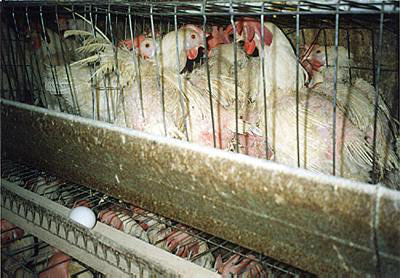
Hens confined to battery cages
'Laying hens' are also de-beaked (practically universal in U.S. intensive plants, but often done twice, due to longer hen lifespans). Often in larger outfits, only about 100 hens have their laying and food intake counted, and when they are no longer economical to keep (usually at 18-24 months), the whole, e.g., 90,000 of a laying group are sent to processors for pot pies or chicken soup. Hatcheries which produce 'egg birds' kill all male chicks (1/2 million daily in the U.S. alone) by such means as suffocating them in plastic bags, then mashing the remains--or even still-living chicks---for fertilizer or food for fur ranched animals. One person looks after tens of thousands of hens, which are kept together in small cages with automated feeding through a trough, and automated 'watering.' The cages, in tiers five to twenty cages high, have sloped floors, so eggs roll forward for collection. The slope makes it hard to stand on the wire floor, through which excrement drops, to be cleaned out once every few months. Hens' feet get damaged, and their nails may become permanently entangled around the wire-mesh of the cages, or their toes' flesh may grow around the wire (they survive if trapped, perchance, near food). Pressed to the wire-mesh, the birds typically lose their feathers, and their skin is rubbed red raw, especially at the tail. Pullets (young 'layers') are kept in complete darkness except at feeding time, and once at laying age, they are subjected to harsh, almost continuous light. Cage sizes vary, but in Britain are commonly 20 ins. wide, 18 ins. deep, with five birds, each with a wingspan of 30 inches, crowded together inside a prison with a floor the size of a full-size national newspaper such as the Globe and Mail. Crowding is yet worse in the States, where up to nine hens can be crowded into an 18-by-24 inch cage (1/3 sq. ft. per bird), or 4 birds may be found in 16-by-12 inch cages. The worst such cage in the States (which has no minimum standard) was reported by Peter Singer as 4 birds in a 12-by-12 inch cage. Thus crowded, the birds are consequently not allowed to fulfil their natural urges to scratch, peck, perch, fly, and walk. Hens may have their food, water, and light withdrawn for 2 days to induce 'force-moulting' (shedding of feathers) which increases egg production. But this practice kills many hens from the sheer shock. Hens are deprived of food for thirty hours before their slaughter. Hens in a field are ordinarily quiet, but pandemonium rules in such massive hen plants; the birds scramble over each other to peck at the automatically controlled grain troughs. In most cages, there is one bird who passively does not resist the aggression of others, and is trampled upon, huddled near the bottom of the sloped floor. Mortality rates for hens are commonly 10-20% per year, usually from stress, but this is still calculated to be the most profitable kind of arrangement for egg production.
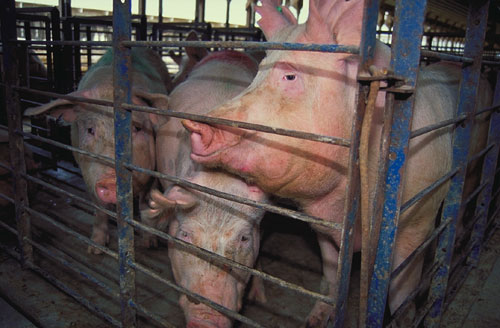
Pigs on an intensive farm.
Intensive farming for pigs is now standard, and Trans-Species Unlimited of the U.S. estimates that 90% of pigs are now raised in factory farm conditions. 80 million pigs are killed for food in the U.S. alone. Some of today's 'pig factories' have more than 100,000. In a 'bacon bin' metal confinement house, 500 pigs get 7 sq. ft. of living space each, just enough to stand up and lie down but not enough to turn around. One man can handle the entire system due to both automatic feeding, and slatted floors which allow the manure to drop below. Floors are mostly slatted or concrete, which invariably damage or deform the pigs' legs and feet as they twist and strain to relieve the pain of feet lesions from the unfriendly floor. Pigs' skeletons are deformed under unnatural weight, without the benefit of any real exercise. Straw bedding is rarely provided because of expense and labour of replacement, except for sow- breeders, who live longer and are worth more dollars. Otherwise, confined without exercise, the pigs gain more fat. Pigs can sometimes lie down, but being so intelligent (more so than dogs), they are bored and unhappy. The pigs are deliberately kept overheated in order to keep them inactive and hence fatter (their sweat glands cannot cope, so they must coat themselves with mud--when permitted under intensive farming conditions). When overcrowded together constantly, pigs take to biting each others' tails. In fact, tail-biting under extremely crowded conditions sometimes leads to eating into a helpless pig from the rear by one of its crazed fellow inmates. So farmers routinely cut off pigs' tails, and this, along with routine castration and ear 'notching,' is done without any anesthesia. Because of stress, some factory farmed pigs 'freeze up,' becoming so fearful they dare not move, even to eat or drink; others remain in constant, panicked motion, a neurotic perversion of their need to escape. Stress often causes rigidity, blotchy skin, panting, anxiety, and frequently, sudden death, e.g., from a heart attack. Confined pigs can be overstressed, indeed shocked to death, by loud noises, bright lights, or the farmer's dog. Still, these cruel, close confinements are found to be more profitable. Despite popular myths, pigs are naturally clean and would never willingly soil their resting areas. They also chew food slowly, sniff it discerningly, and never overeat unlike horses, dogs, and us, except when pigs are fed a drug like 'hog-crave,' which is used to fatten them for market. The unbearable stench in these 'factories' is especially hellish for the pigs with their highly developed sense of smell, which can detect edible roots while they are still underground. Pigs sometimes drink 'water' that is distilled liquid waste--this being the only 'water' offered to them on factory farms. Over 80% of pigs today have pneumonia at the time they are slaughtered, due to poor air quality during their rearing.
Pigs are weaned early so that the sow can be re-impregnated sooner. Some factory farms keep the young pigs in tiered wire cages, where excrement falls on lower pigs' bodies. Sows are often almost constantly confined to become 'machines' for reproduction and birth. They now yield 20 piglets annually instead of the traditional 6. Sows and piglets both grieve their overweaning forced separation. While pregnant, a sow may be confined (to save space, labour, and freed 'worked off' in exercise) to a pen and/or tethered so that she can stand up or lie down, but not turn around or otherwise exercise. When ready for birth, the sow will be moved to an 'iron maiden,' a device to keep her from rolling over and unnaturally crushing her piglets (this tragic event---possibly a form of euthanasia, parallel to captured baboons biting off the heads of their young, or minks devouring their young on fur farms---can be prevented more humanely).
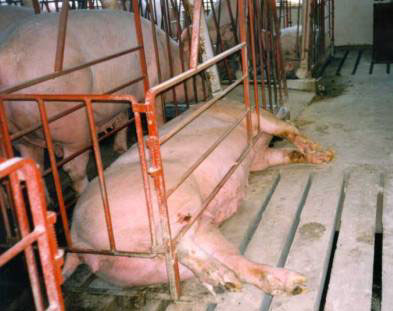
Sow confined to "iron maiden"
So piglets must suckle from their mothers through iron bars. Sows, under constant close confinement, gnaw at the iron bars of their stalls. Only when placed (likely indoors) with a boar does she briefly have the freedom of more room (at best for a few days); once artificial insemination in pigs is universally used, this freedom, too, may cease.
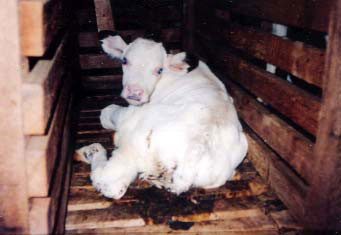
Young son of a cow used for milking, confined to so-called "veal crate"
Veal calf raising is at a level of cruelty comparable only to force-feeding geese through a funnel to inflate their livers to make them deformed, infected, and oversized...paté. Male 'dairy calves,' who provide no milk and make poor 'beef cattle,' are eventually reduced to veal meat. 'White veal' used to be slaughtered for their pale flesh at 150 lbs., not much more than their birth weight, but science has produced white veal meat on animals that are standardly 350 lbs. Auctioned after early weaning (mothers mourn for their calves by bellowing at the top of their lungs for several days, indicating they both think and feel), affection- starved veal calves, often with umbilical cords still dangling from their navels, are quickly confined in a stall 19-22 ins. wide and 4 and 6 ins. long by their third or fourth day, with a slatted floor raised above the concrete floor of the shed (for manure disposal), which becomes slippery, and so frequently causes the baby calves to fall. They are commonly tethered around the neck when very young to prevent them from turning around in their stalls and gaining muscle, but when older, they are already too big to be able to turn around in their stalls. Yet veal calves must lie in a position that no cow would normally assume. The calf, when he can lie down, must do so in a hunched position, on top of his legs (and on top of his excrement, which also covers his coat), never with his legs stretched out, and since the knees are overused for standing and lying down, they become swollen. These creatures are naturally playful, but are not even permitted to walk, let alone run and play, and this curtailment of exercise is enforced in order to keep them 'tender' or with minimal muscle development. Close confinement leaves them helpless amidst hordes of flies. The calves cannot even turn around in order to groom themselves with their tongues when older. Feeding takes only 20 minutes a day, and the rest of the day is a hell of boredom, wherein they are observed to grind teeth, and incessantly wag their tongues and tails. To avoid restlessness, they are kept in the dark. Many go blind under such conditions.
'Veal calves' are deliberately kept deficient in iron (no iron, however, would kill them, but calves are permitted no surplus of iron), which leads to chronic anemia, to satisfy a consumer preference for pale, sickly flesh. The calves do not eat grass, which would give them coloured flesh, but rather a liquid, non-fat milky diet, with added growth drugs, routine medicines, vitamins and minerals (but low iron). The stall will have no straw or other bedding, as eating straw will spoil the paleness of the flesh, and so the floor remains hard and uncomfortable. They lick any iron fittings in their cages because anemia leads to iron craving, so the animals are often kept in hardwood stalls. Another reason for keeping the calves from turning around is that they will otherwise lick their urine for iron, despite a natural repugnance for urine. Moreover, the calves might easily get infections from exposure to manure. The producers, of course, prohibit urine as a source of iron and indirect cause of infection. The lack of roughage (they are given no solid food to chew on, although they have a natural need to chew their cud) commonly gives the calves stomach ulcers, and invariably diarrhea, the stench of which combined with manure's resultant ammonia fumes, in poor ventilation, they must endure with their sensitive noses. The lack of roughage may cause them to try to chew, in vain, the sides of their stalls. To take in as much food as possible, the calves are given no separate water; they eat more because thirsty, then sweat, and eat more for increased thirst. Obviously, an animal being fat does not mean it is either happy or healthy.
Veal calves live in these conditions for 13-16 weeks before slaughter. Greater stall widths cannot be enforced as long as they are at best merely 'recommended' and not legally required in most countries. Digestive, infectious, and respiratory diseases (many get pneumonia, as they are deficient in antibodies normally provided through their mother's milk, which is of course withdrawn very early) are widespread, and calves are routinely fed medication, and given extra dosages once afflicted, which practice is dangerous for humans as the latter become immune to the drugs like penicillin and tetracycline through consuming residues in meat. This drugging is also practised widely with other livestock; indeed, 55% of all U.S. pharmaceutical products are given to livestock. The death rate of 'veal calves' is commonly one in every ten calves by the end of the process, and this remains profitable for producers only because veal meat is so expensive while male dairy calves are so cheap.
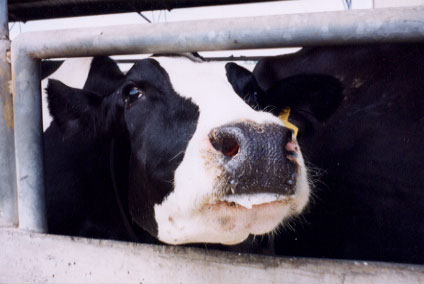
Milked cow languishing in confinement
Obviously, the dairy industry is intimately linked to the veal industry, since dairy cows will produce male dairy calves, useless for milking and not favoured for beef production.
Dairy cows are also subject to semi-confinement systems where they are kept inside a barn for most of the year. Dairy cows are likely to have more freedom as they are brought twice daily to milking parlours, then returned to pasture or, in winter, to a barn. But dairy cows may be kept their whole lives in concrete stalls, or still worse for their feet, on a slatted, metal floor. Some cows are even kept in mobile cages on wheels, which are automatically transported to a milking parlour, and the cage trips switches that automatically initiate cleaning, feeding, and watering the cars; they are then rolled back to the storage area after milking. They live in these cage ten months a year, during which time they cannot walk or turn around. This originated in Europe, although its profitability suggests it may become increasingly widespread. That the cow needs to be milked by humans is a myth, for natural birth provides the calf to drink his/her mother's milk. Only when we 'super- ovulate' the cows by intensive artificial or natural insemination, and then tear away the cows' children, do the cows 'need' us to milk them. Normally, cows are mellow and patient animals, but their nervous systems are run ragged from intensive breeding--they are therefore so tense, nervous, and hyperactive, that they often have to be given tranquilizers. Dairy cows are not kept indefinitely, but are slaughtered for their beef after five years.
Baby lambs, who would otherwise have played in the fields, are sometimes immediately confined in darkness with a mere four sq. ft. of floor and a mechanical teat. Rabbits, turkeys, geese, ducks, and many species of fur-bearing animals, especially minks, are also farmed intensively.
Farm veterinarians are paid by farmers, so that they do not generally hold the animals' welfare as a priority (especially if hired by the big firms), and governments have shown by laws and inspection practices that they wholly back profit-maximization strategies.
A recent study showed that 70% of workers in factory farm confinement buildings have respiratory illnesses due to hydrogen sulfide gas from animal manure in close quarters.
Animal feed on factory farms typically included scrap products such as waxed cardboard containers, poultry manure and feathers, cement dust (for 30% weight gain), and the corpses of unsaleable meat from animals dying before slaughter and those killed because cancerous or otherwise afflicted. Let us follow Sweden's example and outlaw this cruel, greed-motivated 'factory farming' and so at least require less cruel farming.
Most 'beef cattle' (natural lifespan: 20-25 years) roam freely for the first six months, bereft of the additional year or two of grazing which started to disappear in the mid- sixties. For at six months, the cattle are rounded up and fed diets more weight-promoting than grass to fatten the animals for market. And so at half a year old they are harrowingly transported often up to 2,000 miles, to special 'feedlots,' where thousands of cattle are kept in small enclosures on a surface of packed dirt or mud. Upon arrival, cattle are dipped in a trough full of dangerous pesticides. They are fed corn, other cereals, and after 6-8 mos. of this are 'ready' for market. But the feed is often laced with ammonia-soaked sawdust, feathers, shredded newspaper with carcinogenic colour ink (from comics and inserts), processed sewage, inedible tallow and grease, insecticides, antibiotics, and hormones. There are also artificial flavours and aromas added to trick the animals into eating. More than 75% of the 27 million annually slaughtered cows in the U.S. are raised in intensive feedlot systems. Cows do not have stomachs for the rich, concentrated diet of grains, and are always on the edge of indigestion; one farmer compared it to eating three Christmas dinners a day for 150 days. They are given insufficient roughage as this slows down weight gain, and they take to licking each others' coats for more fibre, causing abscesses from ingested hairs. They are not as closely confined as, say, hens, in these lots, with fifty square feet per cow being unusually small (although this is only a space of 5 x 10 feet); however, boredom from the barrenlands is more of a problem. Mortality can range up to ten percent as the cows are exposed to elements on these lots, in both summer heat, and sometimes icy conditions.
Hence rarely, beef cattle are confined in buildings to protect them from the weather (note, of course, that crowding saves building costs), where the cattle each have a mere 14 sq. ft. of space--when at maximum weight, they then lose weight due to overcrowding stress, but this overcrowding still remains a more profitable arrangement because of the greater overall volume produced, refuting again the myth that farmers care for the welfare of the creatures in their charge in order to maximize profit. Beef cattle, when confined, are kept generally in pens rather than stalls, on slatted floors without bedding for ease of cleaning manure, which of course leads to foot deformities and lameness.
As has been the case traditionally, nearly all cattlemen de-horn (to prevent bruising, etc.), brand, and castrate (to promote docility, and gain of fat) their animals, all without anesthesia. Horns have arteries, so bleeding and pain result. Castration is both painful and a shock, although no anesthesia is generally used in the States. Castration involves brutal surgery: slitting the scrotum with a knife, pulling out the testicles by hand, and cutting the cord. A hot iron is used for branding to prevent straying, theft, and to assist record keeping. A red- hot iron is pressed directly to shaved skin for five seconds, after the animal is thrown to the ground and pinned there, or held in a 'squeeze chute' or adjustable crate. Cattle are also likely to have their ears cut into various shapes for identification at a distance. Cows are normally placid, so if they are unlucky enough to be trapped into a rodeo situation, they are given a 'flanking strap,' clinched in the area of the genitals and the intestines. Some 'cowboys' use a tack or nail on this strap, and an electric prod is applied to the cow's rectum before the 'event,' causing both pain and fearful panic in the animal. Where the 'strap' is outlawed, rodeos naturally cease, because so does the bucking of the animals.
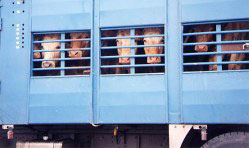
Cows on trucks bound for slaughterhouse
Transportation of cattle often involves men who brutally abuse the animals to get and keep them moving. Trucking cattle is unregulated in the States, unlike railroading, and animals may languish up to 72 hours, without food or water, exposed to the elements in trucks. The meat industry almost always ships cattle by truck nowadays. They commonly lose 9% of their body weight due to stress. The greatest cause of death during transport is pneumonia, although more actually suffered from this 'shipping fever'---cattle not under stress have no trouble resisting the virus that causes the illness. Shipping fever is treated with chloramphenicol. In a small but significant percentage of people, even minute amounts of chloramphenicol causes a fatal blood disorder, aplastic anemia. Indeed, commercial beef has been found to have 100 times the amount needed to kill a person (there is no way of knowing who will be afflicted). Animals who cannot walk after transportation are dragged out. Hogs particularly are slow and wilfully obstinate, and so are abused by transporters who often take out their frustrations over delays on transported animals by kicking, clubbing, etc. Transported animals commonly die from stress, suffocation, hunger, thirst, freezing, and overheating.
At slaughter, all these animals converge: chickens, pigs, cows, veal calves, as well as lamb, geese, ducks, etc.
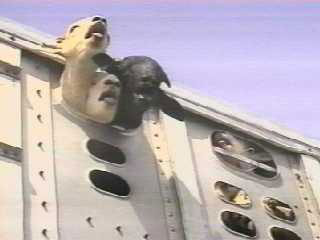
Goats yearning for open air and freedom in slaughter truck
Animals go kicking and screaming, bellowing and fighting to the slaughterer, crying pitifully and stirringly, in shock and horror, to be spared the fate they see befalling their fellows before them. Many animals are electrically stunned and feel no pain at death, their throats slit while unconscious, although prior to death, they feel terror and smell the blood of those who have gone before. Still, Jewish and Moslem rituals require animals to be conscious, or "healthy and moving"; at death (originally to prevent the use of diseased or already dead meat?). These animals kick and thrash for some time after a cut to the throat with a knife. The Pure Food and Drug Act forbids the killing of an animal in the blood of another; when unconscious it is one thing, but conscious ritually slaughtered cattle are hoisted up by one leg for 2-5 mins. or longer, and the sheer weight of 1-2,000 lbs. causes their flesh to tear violently away from the bone, and it often breaks the canon bone. The animal twists around, and so its nostrils are held with a clamp to still the animal while its throat is slitted with a knife. Over 90% of cattle slaughtered in New Jersey are ritually killed (N.J. supplies meat for itself and New York state), as only part (the forequarters) of the cattle is used for kosher meat, from which the blood vessels are easily removed in accordance with Jewish law. The rest of the meat (most of it) is sold generically. Although 5% of flesh bought in the U.S. is kosher, as many as 50% of the animals are slaughtered as such. 28 states in the U.S. are under no compulsion to use humane slaughtering methods. After all, captive bolt guns cost about one cent per animal, and electric stunning equipment is expensive to install. The pole-ax is still used, which must land on a precise spot on a moving cow's head for success; frightened cows move their heads. Skilled men will sometimes miss and crash through an eye or nose, causing much agony before a difficult death. Unskilled poleaxers get practice on live animals. These workers are under great pressure and are in a hurry. What is more, slaughterhouse workers have the highest job turnover rate in the U.S. (a Dodge City, Kansas plant has a turnover rate of 43% per month, equivalent to a complete turnover of 500 staff every 2.5 months), as well as the highest on-the-job injury rate (30% of U.S. workers in slaughterhouses suffer on-the-job injuries needing medical attention).
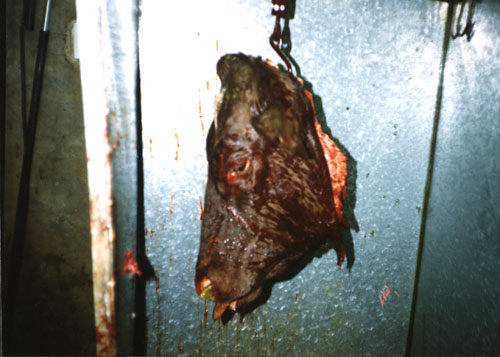
This cow's head was once alive with sensation, part of a whole being, and expressed feelings to those who would heed them--you do not need to choose to be a part of this!
We get 16 times more protein by eating plants only rather than also feeding our crops to livestock, so we could more than solve the world's protein deficit by becoming vegetarians and distributing our food more humanely. In the U.S., farm animals consume 97% of legumes, 90% of grains, and 80% of fish supplies. More than 1/2 of all U.S. water, and 1/3 of all raw materials are used for animal agriculture. U.S. 'organic' farm products may simply mean no drugs or hormones were used---other factory farm processes may be present. In 1986, the journal East-West found that almost all (except 2) "natural" or "organic" farm chickens came from places hardly better than the industry norm and that is much the same in today's largely unregulated market. Moreover, boycott leather: sales of hides plays a significant role in the profitability of factory farming.
All livestock animals show potential for a fairly highly organized social order in a flock, herd, family, or clan, with great capacities for perceiving and feeling. It is estimated that the average meat eater is personally responsible for the slaughter of 22 warm-blooded animals per year, 1,500 in a lifetime, and probably much more owing to family and pets. Another estimate given by the Toronto Vegetarian Association for the average meat eater's death toll in a lifetime is 12 cows, 29 hogs, 2 sheep, 37 turkeys, 984 chickens, and 910 lbs. of fish.
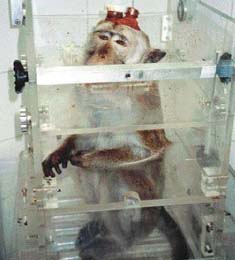
Baboon targeted for vivisection at Hebrew University, Israel
We have already discussed a commercial form of vivisection, namely cosmetics and products testing. Now we shall discuss this practice in general, which is defined as experimentation on living animals that causes harm and/or death (it originally meant 'live dissection' exclusively). I quite agree with George Bernard Shaw's statement in the following:
If you attempt to controvert a vivisectionist by showing that the experiment he has performed has not led to a useful result you imply that if it had led to a useful result you would consider his experiment justified. Now, I am not prepared to concede that position.
Obviously, though, many people are not apt to take this rather austere moral stance, so it can be useful to impugn vivisection on scientific grounds. Shaw is correct, however, in implying that the best and most immediate reason for opposing vivisection is for the animals' sakes. Issues in vivisection include surgery without anesthesia, many cruel and needless experiments (e.g., slowly drowning rats to see how they react to stress), cramped confinement, treatments such as freezing, overheating, crowding, crushing, car-crashing, acceleration, malnutrition, induced aggression or passivity, thirst, hunger, concussion, centrifuge, compression, radiation, inflicted injury, targetting by military weapons (in ballistic, chemical, and germ warfare tests), and misplaced research dollars because drugs and other treatments do not affect animals of different species in the same ways. Lab animals are so stressed by what they see and undergo, they are not normal animals mentally and hence organically, so results are even less applicable to normal humans. Lab animals may have no food but pellets, no contact but with researchers, and cages with wire floors for cleaning manure. Kept in these conditions, they are crazed or inert by the time they are needed for experimentation. A drug tested harmful for a nonhuman animal could be safe and beneficial for humans. A drug safe for a nonhuman animal could prove harmful or fatal for a human. Necessarily and in fact, no drug is approved in any case without prior clinical tests on humans. Clinical tests on humans are always needed; there are no exceptions to this rule in any case.
Animal testing does little to inform, and much to dangerously and even lethally mislead in medical research. Robert Koch's Tuberkulin, once hailed as a vaccine against tuberculosis because it cured TB in guinea pigs, was later found to cause TB in humans. Peter Scholefield, former Executive Director of the National Cancer Institute of Canada, admits that the use of tissue culture has replaced the use of animals in most areas, and that proving a substance carcinogenic or safe in lab mice neither clears it nor damns it for human use. Moreover, an experimental cancer caused by grafting cancerous cells into an animal, or other methods, are entirely different from accidentally developed cancers, especially those in human beings. Similarly, causing of birth defects in animals cannot be extrapolated to humans, according to F. W. Oehme, author of Clinical Toxicology. Just the stress of confinement, isolation, handling, transportation, and noise can affect cancer, infection, and birth-defect test results. Thalidomide was a sleeping tablet that failed to produce any abnormalities in the extensive numbers of animals tested. It produced great deformities in 10,000 human newborns worldwide, including flippers for feet and arms. The morning sickness drug Benedictin caused babies to be born without eyes; Oraflex, the arthritis drug, caused many deaths; Phenformin was a killer diabetes drug--all of these were tested 'safe' on animals.
Digitalis, the main remedy for cardiac patients and saviour of countless lives the world over, was unused for a long time because it was tested on dogs, in whom it dangerously raises blood pressure. The valuable anesthetic chloroform was also withheld as it was so toxic to dogs. Insulin produces deformities in infant rabbits and mice, but not in humans. The discoverers of penicillin say they were fortunate no Guinea pigs were available to test their drug, as it kills these animals. So they used mice instead.
Guinea pigs can safely eat strychnine, one of the deadliest poisons for humans - but not for monkeys. Sheep can swallow enormous quantities of arsenic. A small dose of the mushroom amanita phalloides can wipe out a whole human family, but is consumed without ill effects by the rabbit, one of the most common lab animals. Morphine, which calms and anesthetizes humans, causes maniacal excitement in cats and mice, and dogs have 20 times the tolerance of humans for the drug.
Animals are by nature immune to most human infections--diptheria, various flus, typhus, scarlet fever, German measles, smallpox, cholera, yellow fever, leprosy, bubonic plague, and even the common cold, while other infections such as TB, and various septicemias, take up different forms in nonhuman animals.
The use of animals in drug studies has virtually no statistical predictive value. Although a treatment found effective on animals may occasionally prove useful for human patients, it is just as likely that the treatment will be useless or dangerous. Drugs companies defend their use of animals mainly because they hope this research will protect them against expensive lawsuits over drug disasters.
According to Neal Barnard of Physicians' Committee for Responsible Medicine (more than 1,500 members) in Washington, D.C., the single biggest medical advance on the single biggest North American killer (heart disease) was finding the link between cholesterol levels and heart attacks, which was not discovered from force-feeding butter to animals, who do not get heart disease, but from human trials. Chicken has as much cholesterol as beef. Fish provides no additional benefit to those who eliminate cholesterol sources from the diet (through vegetarianism) and limit saturated fats. John Robbins states that meat-eating males have a 50% chance of dying from a heart attack, whereas pure vegetarians reduce this chance to only 4%. High protein, especially meat, diets lead to osteoporosis, due to calcium leached from bones, and also kidney disease.
Dr. Barnard asserts that clinicians are not interested in the animal studies. He claims that the coronary by-pass, considered the crowning glory of animal research, has swallowed a lot of research money, but has not altered the course of heart disease. Many die from the operation, and it is not as effective, overall, as changing lifestyle habits like eating and exercising.
As for the much-touted heart-transplant, foreign hearts are rejected by the body unless the immune system is severely and constantly suppressed with drugs (or unless the donor is an identical twin), which makes the subject extremely vulnerable to infectious diseases, cancer, and in fact all diseases. Immunosuppression is currently the mainstay of transplant surgery.
In keeping with this theme, the U.S. Centre for Disease Control estimates the relative importance of certain variables for the reduction in the 10 major causes of death over the years (human mortality rates dropped 69% from 1900-1973): life style 51%, environment 20%, heredity 19%, and medical services 10%. And certainly the vast majority of medical advances, it can be contended, are from studies of humans; many claim that animal research has been nearly useless, despite vivisectors' dubiously substantiated claims to the contrary, arising chiefly from their monetary and sometimes sadistic (yes, if one reads many of the pointless and cruel experiments done) vested interests. Therefore, the health benefits derived from animal research are minimal, to put it mildly, and perhaps even negative (both through giving misleading results, and through retarding real research funding and progress).
Self-glorifying researchers commonly do not tell the truth about insulin. Initial diabetes experiments were done with autopsy studies on humans with damaged pancreases. Banting and Best later induced diabetes surgically on dogs they kidnapped from the streets of Toronto. If we started from scratch today, we could have done it entirely with human tissue culture. Moreover, sanitation is what got rid of polio (in the '50's, open sewers were covered up and little bodies of water cleaned up), which was naturally on the decline anyway (it went from 39 to 15 per 100,000 in the ten years before the vaccination was in effect, and it also declined in relatively unvaccinated rural populations at the same rate as in urban settings).
Chloroform, ether, laughing gas, iodine, digitalis, quinine, aspirin, belladonna, and strophantin were all found without resorting to animals, as were fever thermometers, pulse counts, microscopes, stethoscopes, percussion diagnosis, x-rays, and understanding auscultation, the importance of hygiene, and asepsis in surgery.
It is hard to estimate how many animals are vivisected each year for lack of record-keeping, but the North American number is surely in the tens of millions. Even common laboratory rats, through years of special breeding, are intelligent, sensitive, and gentle animals, yet receive little sympathy for the tremendous suffering they are put through.
British medical students have not performed surgery on animals in this century, yet no deficit has been apparent in their training. Harvard medical students conduct a dog lab to practice surgery with outdated equipment, often inadequate anesthesia, and unsterile conditions. Surgical exercises on dogs, the favourite animal surgical subject (although pigs, for whom people unjustifiably have less sympathy, are presently coming into vogue as surgical victims), cannot develop surgical skills with respect to human patients, as so many physicians openly acknowledge. Hans Ruesch reports:
In the dog's narrow, peaked chest the operational field is so different from man's that operations require in part specially built instruments. Also the shape and disposition of all organs differ markedly. So the surgeon who has learned to locate, say, the femoral artery in the dog will find it hard afterward to locate it in a human patient. And the skin, tissues, tendons, in sum all the parts of the dog, react differently under the knife, being either more elastic or tougher or less so than in man. The postoperative reactions also differ. So all nonhuman animals are much less subject to infections, and the surgeon who has succeeded in cutting up a dog without killing it credits his or her own skill for his or her success rather than the animal's superior resistance: a dangerous illusion.
Ruesch has cited surgeons who claim they were poorly and dangerously prepared for human surgery through work on dogs.
Biomedical research accounts for only 17% of all vivisection in the U.S. (2/3 of U.S. animal research is unpublished and so of no value, leaving only 6% of all biomedical animal research published). A British government committee investigated experiments on animals and found only 25% came into print (the U.S. figure is higher, probably because of the number of minor researchers in colleges), and those published usually had trivial results of no benefit to people. Consider the estimate that in the U.S. 2/3 of animal research does not merit publication, and being unknown, like all unpublished experiments, the usually stupid and cruel experiments are uselessly repeated over and over again. Only a few of these experiments can be alleged to contribute to important medical research (many test new, unneeded products, e.g., cosmetics, and many animals are needlessly used by departments of forestry or psychology). Yet we pay, through our taxes, for most of this vivisection.
Foolish, greedy, and quite possibly sadistic vivisectionists commonly try to address the problem of epilepsy by electroshocking monkeys until they are driven mad, frothing at the mouth, convulsing, and periodically losing consciousness. Such induced hardships in healthy animals can have no basis for comparison with diseased people.
50,000 animals have their brains exposed each year in the U.S., used for psychology experiments in which the creatures' brains suffer cutting, coagulating, removal of tissue, and stimulation by electrical and chemical means. Many more psychology experiments are devoted to seeing how animals react to punishment, such as electroshocks.
Here is an animal researcher's dilemma (particularly for psychology researchers): either they argue that animals are so different from humans that they need not count morally, in which case we must question why these animals are used to project results for humans; or else the researchers concede that the animals used are very similar to humans in important respects (e.g., a rat has a nervous system very similar to a human's, and so presumably feels in a very similar way), in which case it is unclear why these animals are not given greater moral consideration.
Primates are sometimes kept in restraining chairs for more than a year, sitting on metal rods and clamped in place around the neck, torso, and sometimes wrists and ankles. Primates are susceptible to tuberculosis and Hepatitis B, which makes them unsuitable research subjects and forces routine quarantine isolation periods, which stress the animals greatly, sometimes fatally. Contagion of TB and hepatitis from animals has often led to the deaths of a number of lab workers. On average for each monkey delivered to a lab, 4 die from wounds suffered during the hunts, or in the course of transport (dysentry, pneumonia, exposure, suffocation, thirst, hunger, or fear and stress result in fatalities during transport).
Animals are often subject to lethal drug/alcohol and smoking addictions, which are plainly avoidable human vices.
In Britain, more than 23% of the experiments performed annually on animals are mandatory tests of drugs and other products required by law. Researchers regularly perform pointless and painful experiments simply to get published and/or promoted, and often just simply observe the deleterious effects on the animals, compared to similar, previous such experiments. Veterinarians, popularly supposed to be of a profession that cares for animals, routinely conduct cruel and needless experiments on animals as a part of their training.
In spite of all this needless cruelty at taxpayers' expense, animal researchers have no public accessibility or accountability. In Canada, no federal laws protect animals in research labs, while only Ontario, Alberta, and Saskatchewan have any laws about lab animals; the western provinces' laws are only about procuring lab animals, while the Ontario law protects researchers comprehensively, but does little or nothing to protect animals (animal welfare organizations are denied any authority, monitoring powers or responsibility for welfare of lab animals; the confidentiality of researchers, research facilities, and supply facilities is guaranteed; no accountability is required to the public or its representatives; the researcher can use any procedure on laboratory animals, no matter how painful, without fear of legal action; pounds and humane societies are legally forced to hand over the lost or abandoned pets they shelter).
It is true that 10 million animals are killed annually in U.S. shelters and municipal facilities alone, with generally a mere 7% adoption rate, but these animals and those elsewhere should not be subjected to painful, pointless deaths in labs. Researchers deny they purposely acquire former pets from pounds, but in fact they always choose well- behaved, healthy animals, virtually insuring that the animals were once pets. Many states and provinces have pound seizure laws which legally require former pets to be handed over for research, which causes these often previously cared-for animals tremendous stress.
The Canadian Council on Animal Care has only one member organization concerned with animal welfare, whereas the other fourteen member organizations have a vested interest in vivisection (e.g., the Department of National Defence, the Pharmaceutical Manufacturers Association of Canada, and the Medical Research Council). The CCAC visits most labs for assessment about "once every three years"; and the reports following such visits are confidential; the CCAC has never brought forth any animal-welfare- related charges or complaints against a research facility, despite all of the cruel disease inducement, burning, freezing, crushing, starving blinding, beating, shocking routinely done on animals in labs. Researchers themselves unacceptably recommend and apply codes of care for lab animals.
What we need are not alternatives to animal research that give us the same results (which are well-nigh useless), but rather real research, replacement techniques of investigating medical problems. Valid research is poorly described as an "alternative"; to cruel, medical irresponsibility. Some alternatives to vivisection include: human tissue cultures, human diploid cells, mathematical or computer models of biological systems, gas chromatography and mass spectrometry, and films and models for educational purposes. It may be true that in many cases the use of animals cannot be directly replaced, but it should be remembered that what happens in labs to nonhuman animals is itself only rarely directly relevant to humans.
Dickinson, Linda. Victims of Vanity. Toronto: Summerhill Press Ltd., 1989.
Doncaster, Anne (ed.). Skinned. North Falmouth, Massachusetts: International Wildlife Coalition, 1988.
Dunayer, Joan. Speciesism. Derwood: Ryce Publishing, 2004.
Francione, Gary L. Introduction to Animal Rights: Your Child or the Dog? Philadelphia: Temple University Press, 2000.
Regan, Tom. The Case for Animal Rights. Los Angeles: University of California Press, 1983.
Regan, Tom. Empty Cages: Facing the Challenges of Animal Rights. New York: Rowman & Littlefield, 2004.
Robbins, John. Diet for a New America. Walpole, New Hampshire: Stillpoint Publishing, 1987.
Ruesch, Hans. Slaughter of the Innocent. New York: Civitas Publications, 1983.
Singer, Peter. Animal Liberation. 2nd edition. New York: Avon Books, 1990.

